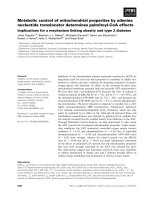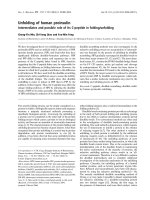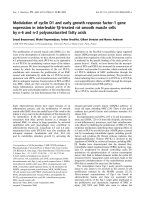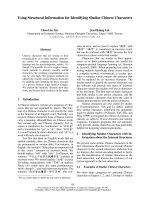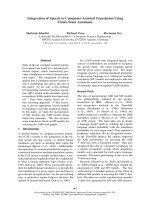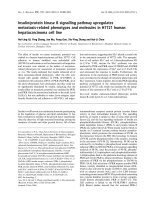báo cáo khoa học: " Social structural factors that shape assisted injecting practices among injection drug users in Vancouver, Canada: a qualitative study" pps
Bạn đang xem bản rút gọn của tài liệu. Xem và tải ngay bản đầy đủ của tài liệu tại đây (270.52 KB, 7 trang )
RESEA R C H Open Access
Social structural factors that shape assisted
injecting practices among injection drug users
in Vancouver, Canada: a qualitative study
Nadia Fairbairn
1
, Will Small
1
, Natasha Van Borek
1
, Evan Wood
1,2
, Thomas Kerr
1,2*
Abstract
Background: Injection drug users (IDU) commonly seek manual assistance with illicit drug injections, a practice
known to be associated with various health-related harms. We investigated the social structural factors that shape
risks related to assisted injection and the harms that may result.
Methods: Twenty semi-structured qualitative interviews were conducted with IDU enrolled in the ACCESS or
Vancouver Injection Drug Users Study (VIDUS) who reported requiring assistance injecting in the past six months.
Audio-recorded interviews were transcribed verbatim and a thematic analysis was conducted.
Results: Barriers to self-injecting included a lack of knowledge of proper injecting techn ique, a loss of accessible
veins, and drug withdrawal. The exchange of money or drugs for assistance with injecting was common. Harms
experienced by IDU requiring assistance injecting included theft of the drug, missed injections, overd ose, and risk
of blood-borne disease transmission. Increased vulnerability to HIV/HCV infection within the context of intimate
relationships was represented in participant narratives. IDU identified a lack of services available for those who
require assistance injecting, with notable mention of restricted use of Vancouver’s supervised injection facility.
Conclusions: This study documents numerous severe harms that arise from assisted injecting. Social structural
factors that shape the risks related to assisted injection in the Vancouver context included intimate partner
relations and social conventions requiring an exchange of goods for provision of injecting assistance. Health
services for IDU who need help injecting should include targeted interventions, and supervised inject ion facilities
should attempt to accommodate individuals who require assistance with injecting.
Introduction
The injection of illicit drugs is a growing public health
concern internationally, and human immunodeficiency
virus (HIV) transmission among injection drug users
(IDU) represents a significant factor driving the global
HIV epidemic. There are an estimated 16 million indivi-
duals who inject illicit drugs worldwide and 3 m illion
injectors living with HIV [1]. Even in settings where a
comprehensive public health response to injection drug
use has been implemented, including needle exchange
and health outreach programs, IDU continue to be
exposed to a range of drug-related harms [2,3].
Recent studies have demonstrated that, even when ster-
ile needles are accessible, individual characteristics and
social structural factors may make IDU vulnerable to syr-
inge sharing and subsequent HIV infection [2,4]. R hodes’
risk environment framework has identified a host of fac-
tors beyond the individual level that shape drug injecting
practices and has illustrated how social context influ-
ences the production of injection-related HIV risks [5].
Social structural factors that may compro mise individual
ability to employ HIV prevention strategies among IDU
include the influence of extended peer networks [6], as
well as prevailing social norms among local populations
of IDU [7]. Situated cultural norms have been shown to
be particularly significant in shaping local and context-
specific drug use risk practices, including routes of
administration and"rituals” of use including drug pro-
curement, exchange, and sharing [8]. Ethnographic
* Correspondence:
1
British Columbia Centre for Excellence in HIV/AIDS, St. Paul’s Hospital,
University of British Columbia, 608-1081 Burrard Street, Vancouver, B.C., V6Z
1Y6, Canada
Full list of author information is available at the end of the article
Fairbairn et al. Harm Reduction Journal 2010, 7:20
/>© 2010 Fairbairn et al; lice nsee BioMed Central Ltd. This is an Open Access arti cle distributed under the terms of the Creative
Commons Attribution License ( which permits unrestricted use, distribution, and
reproduction in any medium, provided the original work is properly cited.
research has highlighted the importance of the “cultural
logics” of the street economy [9,10], as well as the gen-
dered dynamics that often surround the injection process
[11,12], as contextual factors that compromise individual
ability to enact risk reduction strategies.
Previo us work has indicated that a substantial propor-
tion of ID U in various settings internationally receive
manual assistance with injections [13,14]. The role of
‘hit doctor’ (i.e., someone who provides assistance with
injections) was first described by Murphy (1991) who
observed that experienced injectors working in shooting
galleries in the San Francisco B ay area often provided
assistance with injecting in exchange for money [15]. In
Vancouver, Canada, a city with high rates of injection
drug use and HIV among IDU, nearly half of local IDU
have reported receiv ing assistance with injecting in the
previou s six month period [16]. In th is setting, receiving
assistance with injecting has been identified as a strong
independent predictor of syri nge sharing and HIV sero-
conversion, with IDU who report this behaviour being
twiceaslikelytoacquireHIVincomparisontoIDU
who do not require assistance injecting [16,17]. Assisted
injection has also been associated with non-fatal over-
dose among IDU in Vancouver [18].
Given that assisted injection is a highly prev alent prac-
tice known to be associated with severe health complica-
tions in our setting, including HIV infection and overdose,
we conducted a qualitative study to explore the circum-
stances and social conventions surrounding assisted injec-
tion. We sought to pay particular attention to individual
factors as well as the broader contextual forces that shape
the experience and harms of assisted injection.
Methods
This article presents analyses of data from qualitative
interviews with Vancouver IDU who require assistance
injecting. One-to-one in-depth interviews were con-
ducted to explore the following topics: 1) injection-
related knowledge and practices; 2) experiences of
assisted injection; 3) the broader context of assisted
injection, and 4) harmful experiences resulting from
assisted injection.
We draw upon data from 20 in-depth qualitative
interviews conducted during June and July, 2007. Inter-
viewees were recruited from two cohort studies in Van-
couver: the Vancouver Injection Drug Users Study
(VIDUS), which is composed of over 1000 HIV negative
IDU; and ACCESS, which is composed o f over 500
HIV-positive IDU. Database markers were used to iden-
tify participants from these cohorts who reported receiv-
ing assistance with injecting. Given the large
representation of female IDU requiring assistance inject-
ing in our setting [13,17], attempts were made to recruit
female IDU for the present study.
Interviews were undertaken by three different trained
interviewers ( Fairbairn, Van Borek, and Small) and
facilitated through the use of a topic guide encouraging
discussion of assisted injection. Interviews lasted
between 30 and 60 minutes, were tape-recorded, and
were later transcribed verbatim. The research team dis-
cussed the content of the interview data througho ut the
data collection process, thus informing the focus and
directio n of subsequent interviews as well as deve loping
a coding s cheme for partitioning the data categorically.
The content of transcribed interviews was catalogued
using a coding f ramework specific to assisted injection
and our ana lysis explores themes that emerged through-
out the interviews. Two members of the research team
(Fairbairn and Borek) separately catalogued the tran-
scribed interview data using a coding framework, thus
allowing for discussion of areas of agreement and
instances of divergence.
All participants in the qualitative study provided
informed consent to participate, and the study was
undertaken with appropriate ethical approval granted by
the Providence Health Care/University of British Colum-
bia Research Ethics Board. There were no refusals of the
offer to participate in the interview and no dropouts
during the interview process. All interviewees received
CDN$20 for their participation.
Results
The study sample consisted of 20 participants, (7 male
and 13 female) who ranged in age from 24 years to
51 years (median age = 40). Participant accounts
described the potential barriers to self-injectio n, namely
lack of knowledge of injection techniques or difficulty
accessing veins due to long- term injecting. Social and
structural factors that shape risk among IDU who
require assistance with injecting were described by parti-
cipants, including intimate partner relationships as well
as the drug scene role of ‘hit doctors’ that require an
exchange of goods for the provision of assistance inject-
ing. Numerous harmful experiences that can result from
assisted injection, namely increased risk for overdose
and infecti ous disease transmission, were represented in
participant narratives. One significant barrier to acces-
sing care and support described by participants who
require assistance with injecting was the rule prohibiting
assisted injection at Vancouver’ssupervisedinjection
facility (SIF).
1. Injection-Related Knowledge and Practices
a. Reasons for Requiring Assistance with Injecting
The accounts of interview participants indicate that sev-
eral barriers prohibit individuals from being able to self-
inject. Several participants described requiring assistance
with injections because they lacked the injection-related
Fairbairn et al. Harm Reduction Journal 2010, 7:20
/>Page 2 of 7
knowledge necessary to self-inject, particularly at the
time of their first injection.
I was thirteen years old and I was running away
from a group home. And my best friend, we were
watching her cousin, and taking license plates, for
when she was working on the street. So at the end of
the night, we go b ack to her hotel room and she
would shoot us some coke, for taking license plates
and that So she would fix herself a nd then she
would fix me. (Female Participant #19)
Individuals described a loss of accessible veins, due to
long-term injecting, as another key barrier to self-injection.
Well, it’ sveins,Ihavenoveins.It’ s all collapsed, or
calloused So there are times I can, every once in
awhile a vein will pop up, and then I can use it for a
few times, and then it will go back down If I can’t
get it in two or three times, there’s somebody I know,
you know he can get me in the arm or in my neck.
(Male Participant #6)
Several participants described requiring assistance
injecting due to collapsed veins and choosing to “ jug”
(inject in the jugular vein) in these instances.
I: You do mostly your own injections?
R:Ah,actuallymyboyfrienddoesitnow,because
sometimes I’ m having a hard time with my arms
now, because of all the injecting I did. Having to find
a vein, he jugs me now { } Yeah, I can’t find, like
you know just can ’t find any veins sometimes, so he’ll
go in the neck for me, or I go myself in the neck.
(Female Participant #2)
Some participants required assistance with injecting
on occasion while experiencing symptoms of shakiness
or feelings of anxiety, such as during instances of drug
withdrawal.
Well I’ mjustbeing,I’ m just being really anxious
lately. I don’talwaysneedhelp,butIjustwantto
have that hit. I want to have it I don’t want to fuck
around anymore, my veins are pissing me off.
(Female Participant #9)
One participant described his inability to self-inject
due to a physical disability that prohibited him from
using one of his arms.
My brother, my best friend, usually ties me off and
does it because I have a disability I can’t because of
the handicap. (Male Participant #14)
Within the context of intimate par tner relationships,
several female parti cipants described assisted injecti on
as a way to demonstrate trust and intimacy in addition
to a form of n eeded assistance owing to a lack of injec-
tion-related knowledge or technique.
Yeah my partners have all you know they fixed
right. And usually they it’ s a trust thing again.
Kind of the more you know a person, then they
know your body, how your veins are and stuff right.
So it just works better that way it seems right, you
know. Yeah, yeah and having that bond is also spe-
cial too, which is cool. You know like you care,
right, you don’twanttohurtthem,youdon’twant
them to get hurt you know?{ } Yeah, but usually,
it’ s, my boyfriend w ill do both of us or whatever,
yeah.{ }If he’s a little sick, he might do himself first
or whatever. But usually, I go first. (Female Partici-
pant #16)
I: The only person you ever had jug you was your
husband?
R: Yeah, and then I’d do it for him.
I: He also had trouble with his veins?
R: Ah no, it was just that it was easier for me to do it
for him, because I was already high, and he wanted
to be high at the same time as me, so he’d fill it out,
and I’ d get high, and do him right away. (Female
Participant #10);
b. Exchange for Assisted Injection Services
Participants described the provision of assisted injection
services as a well-established role within the street econ-
omy that typically involves an exchange of money or
drugs.
R: If they’ re going to fix me with a ten paper of
powder, I’d shoot them five bucks.
I: Okay and always you give something?
R: Always It’ s kind of like a cardinal rule down
here. (Female Participant #19)
The amount of money or drugs exchanged for help
with an injection varied and was negotiated between
individuals. One participant described a willingness to
pay more money when feeli ng a greater s ense of
urgency to use drugs.
He likes his rock. I’ll give him the money to go buy it,
or I’ll just give it to him. I mean, he doesn’taskfor
it If I want to get high real bad, it’s worth a lot { }
once I get it in me, and I get the rush, it’ s worth a
million dollars. (Male Participant #6)
Participants described the harms that can arise when
‘hit doctors’ have material incentive to help someone
Fairbairn et al. Harm Reduction Journal 2010, 7:20
/>Page 3 of 7
inject and may lack concern for preserving the safety of
the individual they are injecting.
It’s [assisted injection] pretty risky, because you really
don’ t know, they could be bullshitting you right?
Because just to make that extra dollar or whatever
(Female Participant #4)
Because of this risk, participants emphasized the
importance of having a trusting interpersonal relation-
ship with a ‘hit doctor’.
I’ve had people that like, ok, like, last night, I said" M
Ineedyourhelp.” He goes"What’ sinitforme?” I
said” Absolutely nothing” until today and then I get
him back. But a lot of times, they see if they’re being
paid for it { } But anyways last night I was
saying,"Ineedyou,andIknowyoucandothis,but
how are you feeling"? He’s got ba d eyesight, and he
can’ t buy glasses but I trust him, the trust factor is
first. And then it’s the physical, could he do it and
see it? (Female Participant #9)
2. Harmful Experiences Due to Assisted Injection
Participants identified several potential harmful out-
comes that can arise from relinquishing control over the
injection process. These included missed injections and
consequent health problems, robbery, infectious disease
transmission, and overdose.
a. Missing the Injection
A variety of health complications including abscess for-
mation and other forms of infection can result from
missed injections. The most harmful complications of
missed injections described by participants involved
jugular injection, where the carotid artery, jugular vein,
trachea, and recurrent laryngeal nerve are in close proxi-
mity to the point of the syringe [19].
Yeah, missing my shot in the neck. Th at was the
scariestpart,itwaslikeasharppainrightuptomy
head, and I was numb on t his side for the longest
time. { } He just missed me, and I don’t know, must
have hit a, I don’ t know, he hit something I got
scared, like I thought I was going to be gone or some-
thing, you know. (Female Participant #4)
The worst experience I had was before I got the abscess
at the back of my throat, when somebody was jugging
me, and somebody kicked the fucking, kicked me while
I was getting jugged.{ } And then so two days later,
an abscess formed in the back of my throat, right here.
{ } and I almost died because it formed so fast, and
so quickly. { } and it was starting to block my swal-
lowing, and my breathing. (Female Participant #9)
b. HIV/HCV Transmission
Having one’s syringe unknowingly exchanged (by the
person providing assistance with injecting) for another
containing only water was reported by numerous parti-
cipants. In addition to theft of the drug, concern was
expressed about receiving an injection with a syringe of
unknown origin.
Actually it was my boyfriend too. When he was a
heroin addict he was really bad. [ ] Yeah he, I asked
him to fix me, like I had heroin for sale, and he was
holdingmydopeforme,andIaskedhimtofixme
up one, { } and there I could see him shaking some-
thing, he was putting water in it { } I busted him
right, he was going to switch me. Yeah. And he got
really mad and threw my rig, and threw my d ope
across the street because I busted him. He was going
to gypsy switch [swap rigs for one filled with water]
me. (Female Participant #4)
Many IDU described relying on a ‘hit doctor’ to pro-
vide injection equipment in addition to administering
the injection, resulting in vulnerability to HIV and other
infectious diseases.
I: Is there anything else that you worry about when
you’re going to have someone else fix you?
R: Well not just about them switching rigs, but you
don’t know if the rig that they’re giving you has HIV
in it or not. { } Well, yeah, like two weeks ago I
fixed with a rig that had blood in it just because I
was that dopesick. (Female Participant #19)
Syringe sharing between intimate partners who pro-
vide assistance injecting one another was a potential
route of infectious disease transmission described by
several participants.
R: When I first started fixing heroin. Yeah my boy-
friend would jug me and that , we had this big can-
ister. We’ djustthrowourusedrigsinthereand
usually when we’d wake up, if we were do pesick, we
would just grab any rig out of the container.
I: Okay and so, would you usually get injected first?
R: No, he would do h imself first and then me.
(Female Participant #19)
When I had a boyfriend he used to inject me, but he
used to do bad things though, change the needles
and stuff especially in my neck, he’d just push it in,
in my neck went like this, you k now, but he’ d
switched the rig I got Hepatitis C from him, ‘cause
he gave me his bloody fix one time, that’showIgot
Hep C. (Female Participant #5)
Fairbairn et al. Harm Reduction Journal 2010, 7:20
/>Page 4 of 7
c. Overdose
Accidental overdose was commonly reported. Several
participants described incidents that involved misco m-
munication over the amount of drug to be injected
which lead to overdose.
I used to throw the whole half a gram in the spoon
right, but I mixed up rigs, different rigs for each
amount, like 20 units in each one. I threw a half i n
there, and I turned my back, thi s other guy threw a
¼graminthereandIdidn’t know about it Boom,
he fixed m e, I g ot half way and I told him to sto p,
stop. I said,"No, no, don’ t do that”.Hewasgoingon
and on and he said,"It’ sokay,I’ m almost there”.I
said,"No, no wait a minute”. And boom, he pushed it
in. I sta rted vibrating, I wa s feeling like, Holy Sh it.
And I’ mgoing"Oooh”.LikeI’ m really starting to spin
and everyth ing. He’s goi ng,"are you okay”.Isaid,"I’m
okay, just don’ttouchme”. He said,"No, no you need
to get up and walk”. And he grabbed me by the arm
andpulledmeup.Itooktwosteps,andeverything
went white. (Male Participant #3)
This one girl she didn’t tell me not to push it all in.
So I smashed it all in and right after, before I
pulled the needle out, she goes"You weren’t supposed
to put it all in” and then just, she just turned into
like a robot. She was like, she started running,
blindly, running in to telephone poles, running into
walls, into everything and just, holy smokes, I
couldn’t believe what was going on. (Female Partici-
pant #19)
3. Barriers to Injecting at the SIF
A number of participants described the rule prohibiting
assisted injection at Vancouver’ s SIF as a barrier to
engaging in safe injecting p ractices. The SIF is a place
where IDU c an inject pre-obtained illegal drugs u nder
the supervision of nurses trained to provide an emer-
gency response in the event of overdose. Presently, only
verbal direction and limited manual assistance (exclud-
ing the act of injecting) is permissible f rom staff. Some
participants noted that this assis tance enabled them to
administer their own injection, while others were still
unable to self-administer their injection. Many of these
individuals reported that they had to then leave the
facility to find another ID U in the nearby alleys to assist
with the injection.
I: Have there ever been times when you’ve needed to
get some help with an injection, and you couldn’ t
find somebody to help you out?
R: Yeah. I had to really take my time to, I had to get
Insite to help me, to direct me, because I couldn’ t
find nobody else that was safe. { } Yeah, I had to do
it myself and eventually, I got it. { } They just direc-
ted me, l ike you know, like telling me which way to
go. { } Yeah, they talked me through it.
I: Have y ou ever gon e in t here to fix , and t hen not
been able to get it done yourself?
R: Yeah, I have. Go outside and see somebody there
to jug me, yeah, that has happened. (Male Partici-
pant #2)
R: Like actually last night, it was so weird, I go,
‘Well, I’m going to go inject, and then come back in
here [InSite]’.It’s because I hadn’t been able to inject
myself properly, and so I needed somebody to jug me
and you can’ tgetanyassistanceatallandsome-
times I just can’ ttakethetimeoutwithmyself,
I can’t be with myself enough to actually inject myself
properly and fast. Like ‘cause I want to get it in me
too fast, I get too anxious, ‘ get in’ . And now, that’ s
why I end up with shit like this [injection-related
infection] on my arm, right? (Female Participant #4)
Some individuals reported that they would not use the
SIF because of the rule prohibiting assisted injection.
I: What about that rule at INSITE where you ca n’t
get help with an injection?
R: That’s the reason why I won’t go there. I think that
sucks. That, it’ s not good, it’s, they should do s ome-
thingaboutsomethinglikethat.‘ Cause what hap-
pens if I want to go in there, and need help and
nobody will help me? Well what’sthisplaceherefor
then? (Male Participant #5)
Discussion
We identified a range of individual, social, and structural
factors that shape the context of risk associated with
assisted injection. The perspectives of participants in the
present study highlight several barriers to self-injection,
including lack of injection-related knowledge and tech-
nique, inability to access veins due to long-term inject-
ing and physical disability. We documented a variety of
harms that can result from relinquishing control over
the injection process and identified various social factors
that shape these harms, including intimate partne r rela-
tions and social conventions requiring an exchange of
goods for provision of injecting assistance. The rule pro-
hibiting assisted injection at Vancouver’s SIF was identi-
fied as a structural barrier to receiving injection-related
instruction and support.
Participant accounts detailing assisted injections high-
light the difficulty in ensuring that a syringe is steril e
when obtaining assistance with injecting, and may help
shed light on previous work that has found the charac-
teristic of requiring assistance with injecting to be an
Fairbairn et al. Harm Reduction Journal 2010, 7:20
/>Page 5 of 7
independent predictor of HIV seroconversion [17]. Sev-
eral participants in the present analysis described bor-
rowing syringes and injection equipment from the ‘hit
doctor’ when receiving assistance with injecting. These
descriptions may help expl ain findings from previous
research indicati ng that requiring help injecting is inde-
pendently associated with reporting borrowing aused
syringe a nd providing assistance injecting (e.g., being a
‘ hit doctor’) is independently associated with lending
one’s own syringe [13,19]. Switching of syringes by the
‘ hit doctor’ in order to steal drugs was commonly
reported, and represents one important route by which
HIV transmission may occur for individuals who receive
assistance with injecting. Additionally, the finding that
miscommunication and confusion surrounding the
quantity of drugs administered may occur during
assisted injections helps shed light on the previous epi-
demiological findings indicating that this practice is also
associated with non-fatal overdose.
Narratives from several female participants portrayed
assisted injection as an opportunity t o share in the
injecting process and drug high, thereby fostering an
increased sense of trust and intimacy. Assisted injection
as a symbolic act in the context of intimate relationships
may therefore represent an important point of intersec-
tion of sexual and injecting dynamics, comprising a"dual
risk” for HIV acquisition [20]. Previous qualitative work
has investigated the gendered dynamics surrounding
assisted injection by documenting women’s experiences
of theft and violenc e, including e xperiences of abuse
from intimate partners when being injected with illicit
drugs [12,21] . Though no such accounts were documen-
ted in our study, the gendered dynamics of assisted
injection begs further exploration given that women are
twice as likely as men to report requiring assistance
with injecting in our setting [13,17].
IDU who require assistance with injecting unani-
mously reported an exchange of money or drugs in
return for the provision of injecting assistance. This
exchange of resources situates assisted injection services
within the street economy and introduces the possibility
of harm in instances where ‘hit doctors’ provide assis-
tance with injecting purely for lucrative benefit [14,15].
This exchange-for-service dynamic may further exacer-
bate harms for IDU who require assistance with inject-
ing by increasing the likelihood of violence resulting
from disputes over compensation given the lack of an
authority to resolve such disputes.
Vancouver’s drug policy response to the ongoing HIV
epidemic has involved the implementation of numerous
harm reduction strategies including needle exchange
programs, a heroin maintenance trial, and a SIF [22].
A current limitation of many SIFs, including the one in
Vancouver, is that operational guidelines prohibit
assisted injections on th e premises due to concerns over
civil liability should assisted injections be permitted
within S IFs [23,24]. However, given the significant bar-
riers to accessing care an d the increased risk of HIV
infection for individuals who require assistance with
injecting, we recommend reconsideration of this policy.
Indeed, a previous study of an unsanctioned drug-user-
run SIF documented the successful implementation of
an assisted injection policy, which resulted in many indi-
viduals developing the competency to self-inject [25].
The present study has several limitations that warrant
acknowledgement. Firstly, our findings are based upon
interviews with lo cal IDU pa rticipating in the current
study. While an eff ort was made to ensure that th e
study sample reflects the demographics of the local
drug-using population who require assistance injecting,
some perspectives may nonetheless be underrepresented.
Secondly, as injection drug use is a highly stigmatized
behaviour, it is possible that social desirability bias
affected the responses of some participants. Thirdly, the
data collected and analyzed here presents only the view-
points of IDU; the results of this analysis should be
compared with the findings of ethnographic research
utilizing participant-observation within the SIF.
In summary, we found that ba rriers to self-inj ecting
included a lack of knowledge of injection practices,
symptoms of anxiety or withdrawal, or a loss of accessi-
ble veins. Our qualitative data indicate that numerous
harms can result from the practice of assisted injection,
notably increased risk for infectious disease transmission
and overdose. Some women reported a preference to
have a partner inject in order to develop trust and inti-
macy, underscoring the importance of considering social
and contextual factors when examining infectious dis-
ease transmission among IDU. Participants identified
the rule against assisted injection at the SIF to be a sig-
nificant barrier to accessing health care, a nd therefore
this policy should be re-evaluated.
Acknowledgements
We would particularly like to thank the VIDUS and ACCESS participants for
their willingness to be included in the study, as well as current and past
VIDUS and ACCESS investigators and staff. We would specifically like to
thank Deborah Graham, Tricia Collingham, Caitlin Johnston, Steve Kain, and
Calvin Lai for their research and administrative assistance. The authors also
wish to thank the staff of Insite, the Portland Hotel Society, Vancouver
Coastal Health (Chris Buchner, David Marsh, and Heather Hay). This study
was supported by Canadian Institutes of Health Research (CIHR) grants MOP-
81171 and RAA-79918. Will Small is supported a Michael Smith Foundation
for Health Research (MSFHR) Senior Graduate Studentship and a CIHR
Doctoral Research Award. Thomas Kerr is supported by the Michael Smith
Foundation for Health Research and the Canadian Institutes of Health
Research.
Author details
1
British Columbia Centre for Excellence in HIV/AIDS, St. Paul’s Hospital,
University of British Columbia, 608-1081 Burrard Street, Vancouver, B.C., V6Z
Fairbairn et al. Harm Reduction Journal 2010, 7:20
/>Page 6 of 7
1Y6, Canada.
2
Department of Medicine, University of British Columbia, 10203-
2775 Laurel Street, Vancouver, B.C., V5Z 1M3, Canada.
Authors’ contributions
NF and TK were responsible for the study design and prepared the first draft
of the analysis. NVB, WS, and EW assisted with the main content and
provided critical comments on the final draft. All of the authors approved
the final version submitted for publication.
Competing interests
The authors declare that they have no competing interests.
Received: 20 August 2009 Accepted: 31 August 2010
Published: 31 August 2010
References
1. Mathers BM, Degenhardt L, Phillips B, Wiessing L, Hickman M, Strathdee SA,
Wodak A, Panda S, Tyndall M, Toufik A, Mattick RP: Global epidemiology of
injecting drug use and HIV among people who inject drugs: a
systematic review. Lancet 2008, 372:1733-1745.
2. Wood E, Tyndall MW, Spittal PM, Li K, Hogg RS, Montaner JS,
O’Shaughnessy MV, Schechter MT: Factors associated with persistent
high-risk syringe sharing in the presence of an established needle
exchange programme. AIDS 2002, 16:941-943.
3. Tyndall MW, Wood E, Zhang R, Lai C, Montaner JS, Kerr T: HIV
seroprevalence among participants at a Supervised Injection Facility in
Vancouver, Canada: implications for prevention, care and treatment.
Harm Reduction J 2006, 3:36.
4. Wood E, Tyndall MW, Spittal PM, Li K, Kerr T, Hogg RS, Montaner JS,
O’Shaughnessy MV, Schechter MT: Unsafe injection practices in a cohort
of injection drug users in Vancouver: could safer injecting rooms help?
CMAJ 2001, 165:405-410.
5. Rhodes T, Kimber J, Small W, Fitzgerald J, Kerr T, Hickman M, Holloway G:
Public injecting and the need for ‘safer environment interventions’ in
the reduction of drug-related harm. Addiction 2006, 101:1384-1393.
6. Neaigus A, Friedman SR, Curtis R, Des Jarlais DC, Furst RT, Jose B, Mota P,
Stepherson B, Sufian M, Ward T, et al: The relevance of drug injectors’
social and risk networks for understanding and preventing HIV infection.
Soc Sci Med 1994, 38:67-78.
7. De P, Cox J, Boivin JF, Platt RW, Jolly AM: The importance of social
networks in their association to drug equipment sharing among
injection drug users: a review. Addiction 2007, 102:1730-1739.
8. Dietze P, Jolley D, Fry CL, Bammer G, Moore D: When is a little knowledge
dangerous? Circumstances of recent heroin overdose and links to
knowledge of overdose risk factors. Drug Alcohol Depend 2006,
84:223-230.
9. Bourgois P: The moral economies of homeless heroin addicts:
confronting ethnography, HIV risk, and everyday violence in San
Francisco shooting encampments. Subst Use Misuse 1998, 33:2323-2351.
10. Moore D: Governing street-based injecting drug users: a critique of
heroin overdose prevention in Australia. Soc Sci Med 2004, 59:1547-1557.
11. Bourgois P, Prince B, Moss A: The everyday violence of hepatitis C among
young women who inject drugs in San Francisco. Hum Organ 2004,
63:253-264.
12. Tompkins C, Sheard L, Wright N, Jones L, Howes N: Exchange, deceit, risk,
harm: the consequences for women of receiving injections from other
drug users. Drugs: education, prevention and policy 2006, 13:281-297.
13. Wood E, Spittal P, Kerr T, Small W: Requiring help injecting as a risk factor
for HIV infection in the Vancouver epidemic: implications for HIV
prevention. Can J Public Health 2003, 94:355-359.
14. Kral AH, Bluthenthal RN, Erringer EA, Lorvick J, Edlin BR: Risk factors among
IDUs who give injections to or receive injections from other drug users.
Addiction 1999, 94:675-683.
15. Murphy S, Waldorf D: Kickin’ down to the street doc: shooting galleries in
the San Francisco Bay Area. Contemp Drug Probl 1991, 18:9-29.
16. Kerr T, Tyndall M, Li K, Montaner JS, Wood E: Safer injection facility use
and syringe sharing in injection drug users. Lancet 2005, 171:731-734.
17. O’Connell JM, Kerr T, Li K, Tyndall MW, Hogg RS, Montaner JS, Wood E:
Requiring help injecting independently predicts incident HIV infection
among injection drug users. J Acquir Immune Defic Syndr 2005, 40:83-88.
18. Kerr T, Fairbairn N, Tyndall M, Marsh D, Li K, Montaner J, Wood E: Factors
associated with non-fatal overdose among a cohort of polysubstance-
using injection drug users. Drug Alcohol Depend 2007, 87:39-45.
19. Fairbairn N, Wood E, Small W, Stoltz J, Li K, Kerr T: Risk profile of
individuals who provide assistance with illicit drug injections. Drug
Alcohol Depend 2006, 82:41-46.
20. Strathdee SA, Sherman SG: The role of sexual transmission of HIV
infection among injection and non-injection drug users. J Urban Health
2003, 80(Suppl 3):iii7-14.
21. Wright NM, Tompkins CN, Sheard L: Is peer injecting a form of intimate
partner abuse? A qualitative study of the experiences of women drug
users. Health Soc Care Community 2007, 15:417-425.
22. Four Pillars Coalition: Four Pillars: Four Years. Where to Now? Book Four
Pillars: Four Years. Where to Now? Vancouver Drug Policy Program, City of
Vancouver 2005.
23. Pearshouse R, Elliot R: A Helping Hand: Legal Issues Related to Assisted
Injection at Supervised Injection Facilities. Toronto: Canadian HIV/AIDS
Legal Network 2007.
24. Kerr T, Wood E, Small W, Palepu A, Tyndall MW: Potential use of safer
injecting facilities among injection drug users in Vancouver’s Downtwn
Eastside. CMAJ 2003, 169:759-763.
25. Kerr T, Oleson M, Tyndall MW, Montaner JS, Wood E: An evaluation of a
peer-run safer injection site for injection drug users. J Urban Health 2005,
82:265-275.
doi:10.1186/1477-7517-7-20
Cite this article as: Fairbairn et al.: Social structural factors that shape
assisted injecting practices among injection drug users in Vancouver,
Canada: a qualitative study. Harm Reduction Journal 2010 7:20.
Submit your next manuscript to BioMed Central
and take full advantage of:
• Convenient online submission
• Thorough peer review
• No space constraints or color figure charges
• Immediate publication on acceptance
• Inclusion in PubMed, CAS, Scopus and Google Scholar
• Research which is freely available for redistribution
Submit your manuscript at
www.biomedcentral.com/submit
Fairbairn et al. Harm Reduction Journal 2010, 7:20
/>Page 7 of 7


